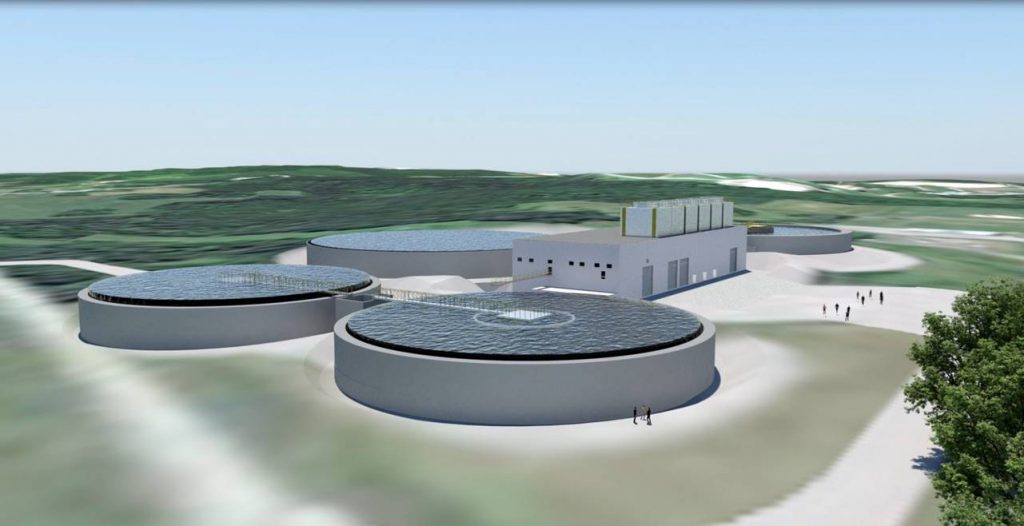
News
Environment & Sustainability
Pulp
Water & Chemicals
Northern Pulp files environmental focus report to Nova Scotia government [UPDATED]
October 2, 2019 By P&PC Staff
 Northern Pulp's proposed effluent treatment facility would consist of an activated sludge system. Photo courtesy Paper Excellence Canada
Northern Pulp's proposed effluent treatment facility would consist of an activated sludge system. Photo courtesy Paper Excellence Canada Northern Pulp and its parent company Paper Excellence Canada have filed the focus report ordered by the Nova Scotia Ministry of Environment about the mill’s proposed wastewater treatment plant.
The report lists third-party assessments that indicate the atmosphere, water and marine life will not experience significant adverse effects from the new drainage pipeline.
The report also contains additional scientific details about the pulp and paper mill’s proposed effluent treatment facility.
In March 2019, then-Environment Minister Margaret Miller (now Gordon Wilson) said Northern Pulp needed to include additional data in its proposal for the new treatment plant that would clarify the potential impact to marine life and on drinking water.
“We have worked incredibly hard over the past six months on this science-based document that we believe will provide a clear path to an approved project,” says Bruce Chapman, Northern Pulp general manager, in a release.
The proposed plan will see the replacement of the existing plant at Boat Harbour with a state-of-the-art wastewater treatment facility. According to the mill, the new system will see a significant improvement in the way treated wastewater is discharged.
Key points from the focus report
In a fact sheet distributed October 2, 2019, Northern Pulp highlighted some key points from its focus report:
- The mill says no history of ice scour was found at the planned location of the diffuser port located outside of Caribou Harbour in 20-metre-water depth. Ocean water quality within five metres of the diffuser will meet Canadian marine guidelines.
- Third party environmental experts have assessed that no significant impacts are expected on any fisheries or fish habitat as a result of this project.
- Within five metres of the diffuser, the difference between the treated wastewater and ocean temperature will be less than one degree Celsius.
- The project will have no impact in terms of accumulation of materials around the diffuser. Stantec summarized that “It is unlikely that sediment will build up in either the near or far-field.”
“Paper Excellence Canada has demonstrated its commitment to Nova Scotia through ongoing environmental improvements,” says Brian Baarda, Paper Excellence Canada CEO. “Today’s science-based report submission is the next step in moving forward with this project that will provide continued environmental protection and economic contribution for the province of Nova Scotia.”
The focus report is now available to the public via Nova Scotia’s Environmental Assessment department.
Modern effluent treatment
The proposed treatment facility project is for a modern Activated Sludge Treatment (AST) system purchased from one of the leaders in treating kraft pulp mill effluent. The system will consist of a Moving Bed Biofilm Reactor (MBBR) followed by conventional Activated Sludge (AS). The system has been designed to process 85,000 m3/day of effluent, well above Northern Pulp’s average flow of 64,000 m3/day.
According to the mill, there would be continuous monitoring of effluent pH, temperature and conductivity and operation of the treatment plant. A spill basin would be added to contain any spills in the event of an emergency such as a power failure. A 15-kilometre High-Density Polyethylene (HDPE) pipeline (chosen for its reliability) will be constructed to deliver the treated wastewater to the receiving water. Sections of the pipe would be fused together to eliminate mechanical joints and fittings.
Leak detection of the pipe would be added to identify issues. The treated effluent will flow from a weir-type discharge at the existing outlet to an engineered outfall diffuser further out into the Northumberland Strait.
Water reduction projects would reduce the effluent flow by 5,000 m3/day in the summer period.
A community divided
In 2015, the province ordered Northern Pulp to stop diverting its untreated effluent through a treatment facility close to the Pictou Landing First Nations reserve and into the waters of Boat Harbour, imposing a deadline of January 31, 2020.
Northern Pulp’s proposed plan includes a new treatment facility constructed on mill property. A 15.5-kilometre water pipe would deliver treated effluent into Caribou Harbour in the Northumberland Strait.
Environmental and fisheries groups in Nova Scotia oppose the new plan, saying the new pipeline will still impact local waters and the fish that inhabit them. Mill representatives maintain that should the application to build a new treatment plant be denied, the mill will be forced to close, which would affect the 339 employees onsite as well as numerous others in the supply chain.
Fishermen created a blockade of boats on the Northumberland Strait – where the new pipeline would pass through – for more than two months in the fall of 2018.
Northern Pulp produces approximately 300,000 tons of NBSK pulp annually.
Print this page